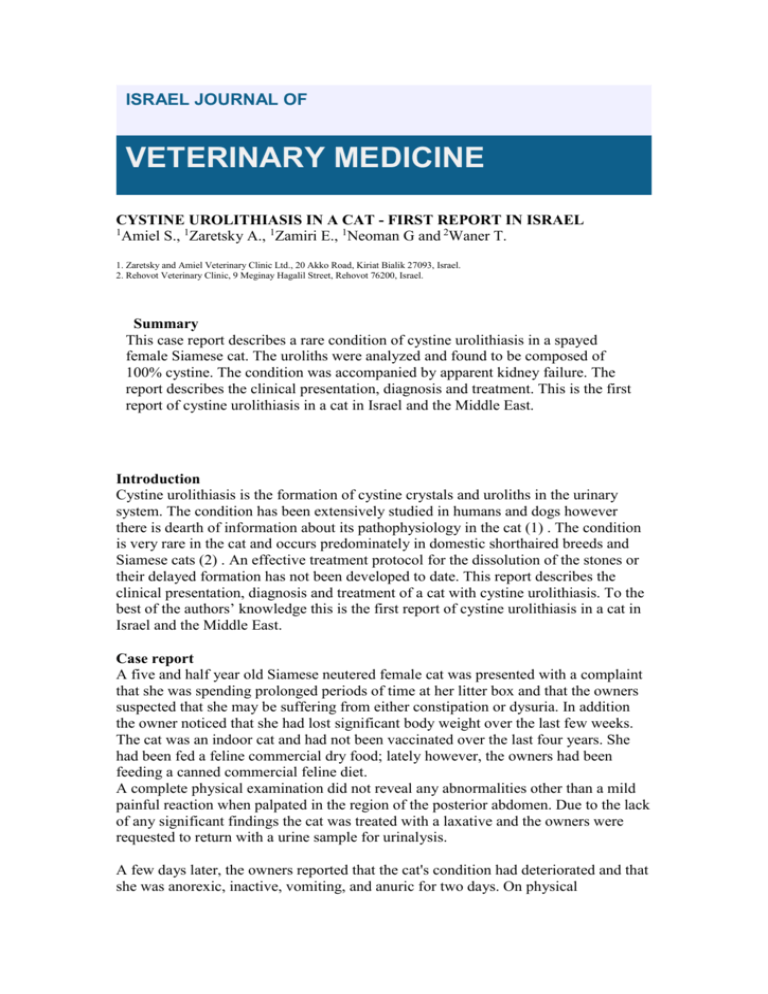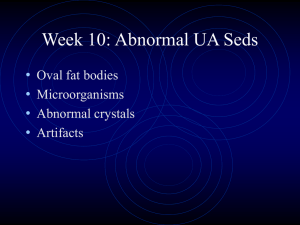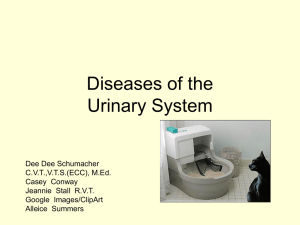CYSTINE UROLITHIASIS IN A CAT -
advertisement

ISRAEL JOURNAL OF VETERINARY MEDICINE CYSTINE UROLITHIASIS IN A CAT - FIRST REPORT IN ISRAEL 1 Amiel S., 1Zaretsky A., 1Zamiri E., 1Neoman G and 2Waner T. 1. Zaretsky and Amiel Veterinary Clinic Ltd., 20 Akko Road, Kiriat Bialik 27093, Israel. 2. Rehovot Veterinary Clinic, 9 Meginay Hagalil Street, Rehovot 76200, Israel. Summary This case report describes a rare condition of cystine urolithiasis in a spayed female Siamese cat. The uroliths were analyzed and found to be composed of 100% cystine. The condition was accompanied by apparent kidney failure. The report describes the clinical presentation, diagnosis and treatment. This is the first report of cystine urolithiasis in a cat in Israel and the Middle East. Introduction Cystine urolithiasis is the formation of cystine crystals and uroliths in the urinary system. The condition has been extensively studied in humans and dogs however there is dearth of information about its pathophysiology in the cat (1) . The condition is very rare in the cat and occurs predominately in domestic shorthaired breeds and Siamese cats (2) . An effective treatment protocol for the dissolution of the stones or their delayed formation has not been developed to date. This report describes the clinical presentation, diagnosis and treatment of a cat with cystine urolithiasis. To the best of the authors’ knowledge this is the first report of cystine urolithiasis in a cat in Israel and the Middle East. Case report A five and half year old Siamese neutered female cat was presented with a complaint that she was spending prolonged periods of time at her litter box and that the owners suspected that she may be suffering from either constipation or dysuria. In addition the owner noticed that she had lost significant body weight over the last few weeks. The cat was an indoor cat and had not been vaccinated over the last four years. She had been fed a feline commercial dry food; lately however, the owners had been feeding a canned commercial feline diet. A complete physical examination did not reveal any abnormalities other than a mild painful reaction when palpated in the region of the posterior abdomen. Due to the lack of any significant findings the cat was treated with a laxative and the owners were requested to return with a urine sample for urinalysis. A few days later, the owners reported that the cat's condition had deteriorated and that she was anorexic, inactive, vomiting, and anuric for two days. On physical examination the following changes were detected: hypothermia (36oC), dehydration (estimated at 8%) and painful posterior abdomen. Palpation of the bladder revealed the presence of urinary stones. Radiology of the abdomen revealed a large number of round stones within the bladder. At this stage hematology and clinical chemistry was carried out (Tables 1 and 2). The complete blood count was unremarkable. The most striking abnormal clinical chemistry results were a marked increase in serum urea and creatinine concentrations. Plasma sodium levels were decreased whereas potassium was increased. Total serum protein, albumin and globulin were all significantly decreased. Other changes included a mild increase in enzyme activity of asparate aminotransferase (AST) and amylase. Urinalysis results revealed hematuria (>250 erythrocytes/µL), proteinuria (estimated 15 g/dL), specific gravity (SG) of 1.020 and a pH of 6.5. The urine was negative for glucose and bilirubin. Microscopic examination of the sediment showed only a few crystals that appeared to resemble triple-phosphate. A large number of leukocytes and erythrocytes and a few granular casts were identified. Treatment At first treatment was aimed at correcting the fluid and electrolyte imbalances and treating the uremic gastritis, and secondly to attend to the primary condition of urolithiasis. In view of the clinical picture and the clinical chemistry results the treatment was initiated and consisted of: 1. Intravenous fluids consisting of Ringers lactate and 10% dextrose solution (Teva Pharmaceuticals, Ashdod, Israel) to correct the fluid balance and attend to the apparent renal failure. 2. Phenoxybenzamine (Dibenyline, Goldshield Pharmaceuticals, U. K) was dosed at a prescribed amount of 0.25mg/kg per os q12h to reduce the internal urethral sphincter tone and allow for the passing of small uroliths. 3. Cimetidine HCl (Cemidin, Dexxon, Israel) and metoclopramide HCl (Praminin, Rafa, Israel) was dosed orally at a dosage of 5mg/kg and 0.2mg/kg q8h, respectively to treat uremic gastritis. 4. Antibiotics were administered: cefazolin (Cefamezin, Teva, Israel) and enrofloxacin (Baytril, Bayer, Germany) at a dose of 30mg/kg q8 IM and 5mg/kg per day PO, respectively. 5. A calculolytic diet (S/D feline formula, Hill’s Prescription Diet) was fed bearing in mind that the most prevalent uroliths are formed from struvite . The cat was hospitalized for two days. The owners were asked to return with the cat to follow-up the serum creatinine and urea concentrations. Two days after initiation of treatment the serum urea level had returned to normal (28.5 mg/dL). At this stage the general demeanor of the cat had improved although she did not appear to have returned to her normal self and appeared to be experiencing abdominal pain. Four days later the general condition of the cat had deteriorated and it was then decided to remove the urinary calculi by surgery due to the painful situation. Cystotomy was carried out and after removal of an abundant number of calculi, the bladder was repeatedly lavaged to remove any residual sediment. Samples of the stones were sent for analysis to the Urolith Center at the University of Minnesota, United States of America (3). The cat recovered well from the surgical procedure and was released on supportive treatment and antibiotics. The cat was now fed a dry calculolytic diet (Renal Programme Diet, Royal Canin). The results of the urolith analysis revealed that the stones were composed of 100% cystine (4) . In the light of these results the diet was changed to Hill’s K/D feline formula (Hill's Prescription Diet). The owners were advised to add salt to the diet to encourage the cat to drink more water and promote an increased urinary volume. In addition a low dose of diuretics was initiated. About two months after the surgical procedure the condition of the cat began to deteriorate. Examination revealed the presence of multiple uroliths that were newly formed. In view of the prognosis and the need for further surgical procedures the owners elected to euthanize the cat. A full post mortem was carried out. Multiple uroliths were identified in the urinary bladder. Histological examination of the kidney revealed mild mineralization of the renal medulla without any other pathological findings in the kidneys or any other organ. Discussion Cystine urolithiasis is the formation of cystine crystals and uroliths in the urinary system. The condition has been extensively studied in humans and dogs and there is dearth of information about the pathophysiology in the cat (5,6) . Cystine is a sulfuramino acid that is normally present in low concentrations in plasma. Normally it is freely filtered by the glomeruli and is then actively reabsorbed by the proximal tubules. Cystine urocystoliths arise due to an inborn error in metabolism characterized by an abnormal transport of cystine by the renal tubules. The presence of cystine uroliths in cats is very rare, and cystine uroliths accounts for about 0.2% of all mineral uroliths types found in cats . In this case the signalment for the presence of cystine uroliths was in accordance with that described in the literature . Cystine uroliths occur in both male and females cats at similar frequencies primarily at about 4 years of age. Domestic Shorthaired (65%) and Siamese (20%) cats are more commonly affected. The initial clinical signs are usually characteristic of feline lower urinary tract disease as was seen in this case and may include hematuria, dysuria, pollakiuria and urethral obstruction. Cystine crystaluria is a characteristic finding in urine samples from cats with cystine urocrytoliths. The cat described in this case also developed transient renal failure. The reason for this occurrence in unclear and has not been described previously in cats with cystine uroliths. A human study showed that impairment of renal function is common in patients with stone-forming cystinuria (7) . Furthermore, another human study attempted to determine the potential impact of cystinuria and cystine stone formation on the level of renal function compared to calcium oxalate stone formers . They found that a significantly greater percentage of cystinuric patients had an abnormally increased serum creatinine compared to calcium oxalate stone formers (8). The postmortem findings did not support any chronic renal changes and so it appears that that the azotemia and increased creatinine levels were due to acute changes in the kidney which resulted in acute transient renal failure. The possibility of post-renal changes due to obstruction of the ureters by uroliths cannot be discounted, although there were no pathological findings to support this option. The possibility that this cat may have also had hypoadrenocorticism cannot be discounted entirely, although the syndrome is very rare in cats. The dehydration and vomiting, as well as the low serum sodium and high serum potassium along with low blood glucose may have been indicative of Addison’s disease. This was not considered at the time of the diagnosis but in retrospect should have been an element in a differential diagnostic list. The treatment of cystine uroliths in cats to promote their dissolution is problematic. N-2-mercatopropionyl-glycine (2-MPG) has been used successfully in dogs and some cats to decrease cystine uroliths (9,10,2) . The drug undergoes thiol-disulfide exchange with cystine to form a more soluble product that is readily excreted. However 2-MPG is considered anecdotally to be toxic for cats and its use is questionable. Complicating the treatment further is the rapid rate of recurrence of cystine uroliths, which range from 2 weeks to about 3 months. In the Siamese cat described here the rate of recurrence was about 2 months after surgical removal of the cystine uroliths. Urohydropropulsion of cystine uroliths has been attempted with moderate success (2) . This technique however requires early detection of the uroliths by radiology while they are still small, and constant and recurrent therapy throughout life. Cystine is more soluble in an alkaline environment and the use of a high moisture (to increase urine volume) and alkalinizing diet is advisable. In this case renal failure diet was fed, which would also give the added advantage of a low protein diet. Despite the diet the cystine uroliths formed rapidly over a period of two months. It therefore appears that this form of therapy was unsuccessful in this case. In conclusion, this case report describes a rare condition of pure cystine uroliths in a female Siamese cat. The cat also displayed transient acute renal failure, an associate condition that has not been described previously in cats with cystine urolithiasis. This is the first report of cystine urolithiasis in a cat in Israel and the Middle East. Acknowledgements The authors would like to acknowledge the assistance and support of Prof. Charles Osborne, and Prof. Shimon Harrus for his encouragement.• References 1. Osborn, C.A., Lulich, J.P., Thumchai, R., Uirich, L.K., Koehler, L.A., Bird, K.A. and Bartges, J.W. Feline urolithiasis. Etiology and pathophysiology. Vet Clin North Am Small Animal Pract. 26:217-232, 1996. 2. Osborn, C.A., Kruger, J.M., Lulich, J.P., Polzin, D.J., Lekcharoensuk, C., Feline lower urinay tract diseases, in Textbook of Veterinary Internal Medicine, S.J. Ettinger and E.C. Feldman, Editors. 2000, W.B.Saunders: Philadelphia. p. 1721-1739 3. Osborn, C.A., Clinton, C.W., Moran, H.C. and Bailie, N.C. Comparison of qualitative and quantitive analyses of canine uroliths. Vet Clin North Am Small Animal Pract. 16:317-323, 1986. 4. Ulrich, L.K., Bird, K.A., Koehler, L.A. and Swanson, L. Urolith analisis. Submission, methods and interpretation. Vet Clin North Am Small Animal Pract. 26:393-400, 1996. 5. Osborn, C.A., Sanderson, S.L., Lulich, J.P., Bartges, J.W., Urich, L.K., Koehler, L.A., Bird, K.A. and Swanson, L.L. Canine cystine urolithiasis. Cause, detection, treatment and prevention. Vet Clin North Am Small Animal Pract. 29:193-211, xiii, 1999. 6. Goodyer, P.: The molecular basis of cystinuria. Nephron Exp Nephrol. 98: 4549,2004. 7. Lindell, A., Denneberg, T. and Granerus, G. Studies on renal function in patients with cystinuria. Nephron. 77:76-85, 1997. 8. Assimos, D.G., Leslie, S.W., Ng, C., Streem, S.B. and Hart, L.J. The impact of cystinuria on renal function. J Urol. 168:27-30, 2002. 9. Johansen, K., Gammelgard, P.A. and Jorgensen, F.S. Treatment of cystinuria with alpha-mercaptopropionylglycine. Scand J. Urol. Nephrol. 14:189-192,1980. 10. Hoppe, A., Dennberg, T., Jeppsson, J.O. and Kagedal, B. Canine cystinuria: an extended study on the effects of 2 mercaptopropionylglycine on cystine urolithiasis and urinary cystine excretion. Br Vet J. 149:235-251,1993. •• •






